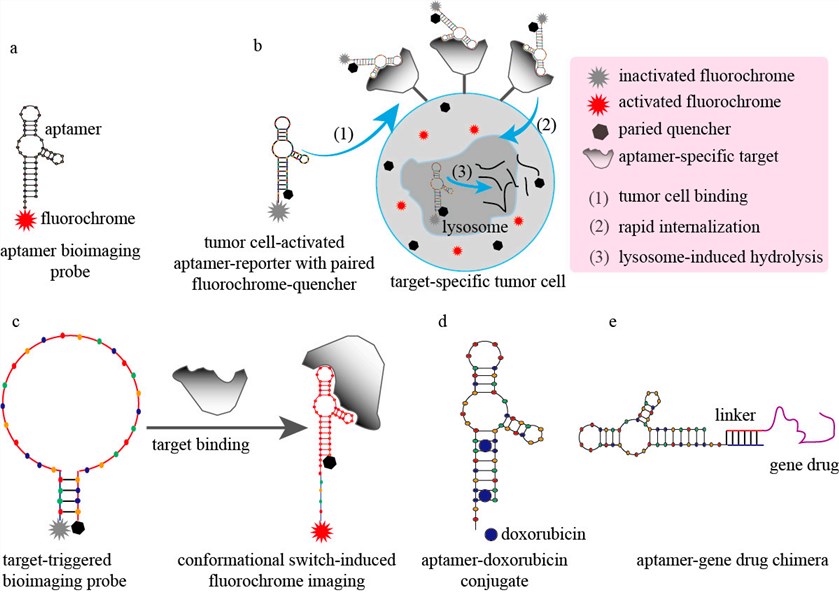It has been over 30 years since aptamers were first described. Multiple unique features of aptamers arouse interest in the development of aptamers for diagnostics. Having been focusing on aptamer applications for years, Creative Biolabs has extensive experience in aptamer research and accomplished lots of relative projects. With accumulated experience from practice, we provide reliable and high-quality aptamer development services to support our clients broaden the application of aptamer in diagnostics.
Introduction of Aptamers as Diagnostics
In vitro diagnostics (IVD) might be one of the most extensively explored areas for aptamer-based biomedical applications. This is in a large part motivated by the unique advantages of aptamers over antibodies or peptide ligand counterparts, in terms of, for example, probe screening, synthesis, modification, and stability including recoverability after denaturation. For instance, aptamers can be developed into aptasensors that sensitively and selectively report the presence of cognate targets. Such a concept can be expanded and combined with nanobiotechnology, microfluidics, as well as synthetic biology. For instance, aptamer-coated microfluidics has been studied to detect, enrich, and isolate target cells, such as circulating tumor cells (CTCs).
Aside from in vitro detection, aptamers have also been explored for in vivo bioimaging. Bioimaging is critical for disease diagnosis, prognosis, patient stratification, as well as the evaluation of therapy responses. Compared with antibodies, the ease of bioconjugation, fast tissue penetration, and rapid body clearance represent potential advantages of aptamers for applications in bioimaging. By modifying aptamers with fluorescent dyes, radioisotopes, or magnetic nanomaterial reporters, aptamers have been explored for molecular imaging by optical bioimaging, positron emission tomography (PET) or single-photon emission computed tomography (SPECT), as well as MRI.
 Fig. 1 Some representative models of modified aptamers for disease diagnosis and therapy.1, 2
Fig. 1 Some representative models of modified aptamers for disease diagnosis and therapy.1, 2
Application of Aptamers as Diagnostics
-
Pathogen Recognition
The fluorescence resonance energy transfer (FRET)-aptamers were developed as a novel high-throughput screening tool against Escherichia coli outer membrane proteins to detect enterotoxaemia E. coli (ETEC) K88. Furthermore, aptamers were utilized to detect surface proteins of Campylobacter jejuni. In addition to using purified bacterial proteins as targets, the whole bacterium-based SELEX procedure was applied to detect E. coli, Lactobacillus acidophilus, Staphylococcus aureus, the virulent strain of Mycobacterium tuberculosis, Vibrio parahemolyticus, Shigella sonnei, and C. jejuni. This led to the development of aptamers with increased affinity and specificity.
-
Cancer Recognition
The development of aptamers for a reliable and timely cancer diagnosis and prognosis evaluation is of the highest importance. To address this issue, aptamers have been developed for the detection of a number of cancer-related biomarkers, including multiple tumor-related proteins in living cancer cells, such as MUC1, HER2, and estrogen receptor. Aptamers for the detection of the MCF-7 breast cancer cells and leukemia CCRF-CEM cells were also developed recently. Furthermore, aptamers have been successfully used for the detection of several tumor-related soluble biomarkers, including carcinoembryonic antigen (CEA), prostate-specific antigen (PSA)… Fluorescently labeled aptamers showed high detection rates of the metastatic tumor tissues. Aptamers were also successfully used for the in vivo imaging of lymphoma, adenocarcinoma, leukemia, glioblastoma, and other cancer types.
-
Monitoring Environmental Contamination
Aptamers have the potential to monitor and to minimize the environmental pollutants and the resulting illnesses. Antibiotics, heavy metals, toxins, and pathogens can be toxic to nervous, endocrine, and reproduction systems. Antibiotics used for farm animals may accumulate in the animal tissues and transmit to humans upon ingestion. To address this issue, aptamers have been developed against some antibiotics, such as chloramphenicol and tetracycline. Furthermore, aptamers for many environmental toxins have been developed recently, including aptamers against ochratoxin A (OTA), bacterial endotoxins, and bisphenol A. Aptamers against mercury, arsenic, copper, and lead have also been generated to identify heavy metal contamination.
Services at Creative Biolabs
With proven expertise in aptamer research, Creative Biolabs provides a comprehensive range of customized, high-quality contract R&D services in aptamer development services to support the application of aptamer in diagnostics. Our range of services including but not limited to:
-
One-stop Aptamer In Vitro Selection Service.
-
Aptamer-based Conjugation Services.
-
Aptamer Modifications Services.
Multiple unique features of aptamers have aroused great interest in aptamer development in diagnostics. With an excellent expert team and advanced technology platform, Creative Biolabs offers reliable aptamer development services to global customers. If you have any other questions, please feel free to contact us.
References
-
Sun, Hongguang, and Youli Zu. "A highlight of recent advances in aptamer technology and its application." Molecules 20.7 (2015): 11959-11980.
-
under Open Access license CC BY 4.0, without modification
Related Product
Questions & Answer
A: Aptamers are short, single-stranded nucleic acids or peptides that can bind specifically to target molecules, such as proteins or small molecules. In diagnostics, aptamers can be designed and selected to recognize and bind to specific biomarkers or analytes of interest. They are used to detect and quantify these molecules, enabling their use in various diagnostic applications.
A: Aptamers offer several advantages over traditional diagnostic methods. They can be generated against a wide range of targets, including small molecules, proteins, and even cells. Aptamers can exhibit high affinity and specificity for their targets, rivaling antibodies. They are also stable, can be easily modified for labeling or immobilization, and are less likely to induce an immune response. Additionally, aptamers can be synthesized in large quantities, making them readily available for diagnostic applications.
A: Aptamers can be used in various diagnostic assays, including lateral flow assays, enzyme-linked aptamer assays (ELAAs), and aptamer-based biosensors. In these assays, aptamers are often conjugated or labeled with detection moieties such as fluorescent dyes or enzymes. The binding of the aptamer to the target molecule generates a signal that can be detected and quantified, enabling the diagnosis or monitoring of diseases or the measurement of analytes in clinical samples.
For Research Use Only.
Related Sections:

 Fig. 1 Some representative models of modified aptamers for disease diagnosis and therapy.1, 2
Fig. 1 Some representative models of modified aptamers for disease diagnosis and therapy.1, 2